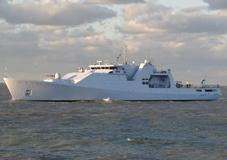WASHINGTON, Sept. 8, 2010 — While the flood waters in Pakistan may be receding, the need for humanitarian assistance is mounting, a U.S. commander based there said today.
“By now, the extent of the disaster should be clear,” Navy Vice Adm. Michael A. LeFever, commander of the office of the U.S. defense representative in Pakistan, told reporters.
“Without a doubt, this is the single worst natural disaster in Pakistan’s history.”
During a briefing at the Pentagon, LeFever described the magnitude of the devastating floods, triggered by heavy monsoon rains, and underscored the ongoing U.S. commitment to support flood-relief efforts.
At the height of the flooding, one-fifth of the nation was submerged. Officials estimate that the floods have affected more than 17 million Pakistanis and destroyed or damaged 1.2 million homes.
The floods also claimed about 1,600 lives, LeFever said, and while that number may seem small in comparison with other recent disasters, it doesn’t begin to convey the urgency of this crisis. A “staggering” number of people are facing life-threatening danger from waterborne diseases, starvation and lack of shelter, he noted.
LeFever said he joined Navy Adm. Mike Mullen, chairman of the Joint Chiefs of Staff, and Gen. Ashfaq Parvez Kayani, the Pakistani army’s chief of staff, on a Sept. 3 aerial tour of the more heavily affected areas, particularly in the south. The extent of the damage was “unbelievable,” the admiral said. “It’s like watching a tsunami wave in slow motion to watch the devastation that’s still occurring,” he added.
LeFever praised the initial U.S. response to Pakistan’s request for aid, which was immediate, he said. Just 36 hours into the flooding, he noted, Air Force C‑130s and C‑17s were flying aid flights, delivering more than 436,000 religiously appropriate meals for distribution to Pakistani authorities.
Six Army helicopters were dispatched shortly after from Afghanistan to Ghazi Air Base in Tarbela to begin relief flights, an effort that continues today with a joint Navy, Marine and Army effort operating from Ghazi in the north and from Pano Aqil air base in the south, the admiral said. And Air Force and Marine Corps C‑130s and C‑17s continue to assist with the transportation of international aid to locations throughout the country, he added.
To help expedite the smooth flow of international aid, a group of about 40 airmen, part of a contingency response element, was deployed to Chaklala, an air force base in the Pakistani capital of Islamabad, he said. The airmen are supporting Pakistan’s civil-military efforts by receiving, unloading and offloading relief supplies destined for Pakistani distribution sites throughout the country.
“The U.S. military has provided a unique capability to rapidly deliver much needed aid and humanitarian assistance,” LeFever said. “Nobody in the world can respond like the U.S. can with its support of strategic airlift and sealift.”
To date, U.S. military aircraft have transported more than 4 million pounds of humanitarian assistance supplies and rescued more than 12,800 people within Pakistan, LeFever said. U.S. officials remain in close contact with Pakistani leaders, he added, and will continue to provide aid for as long as it’s requested by the Pakistani government.
The United States also remains engaged in security assistance, cooperation and counterinsurgency training with the Pakistani military, the admiral said.
While the floods may have drawn away some aviation resources, it has not affected the Pakistani military’s focus, LeFever said. “As far as the number of troops and the focus of the Pakistan military, it has not … wavered in the west or in the northwest,” he said.
LeFever praised Pakistan’s counterterrorism efforts. “They have been engaged in the last 16 months with over 147,000 troops in that area, going after the insurgents that affect their country,” he said. “And so we are there to support them in their efforts to be able to carry out their operations.”
Pakistan is continuing the fight against insurgents, LeFever said, citing a recent air strike in which insurgents were killed in Tirah Valley. “It shows me that they are still very much concerned with the extremists and the operations, and they continue to do that while doing their relief operations,” he said.
LeFever said it’s been “inspiring and noteworthy” to see Pakistanis and U.S. military members working side by side on flood-relief efforts.
“It points to a relationship developed, not overnight, but through years of deepening commitment to learn from one another, [to] build a strong security assistance partnership based on mutual trust and respect,” he said.
“Whether it’s combating floods or working together to safeguard Pakistani people and the region from terrorism, we can all be proud of what’s been accomplished to date to save lives and bring hope to Pakistan,” he added.
Source:
U.S. Department of Defense
Office of the Assistant Secretary of Defense (Public Affairs)

 von
von 